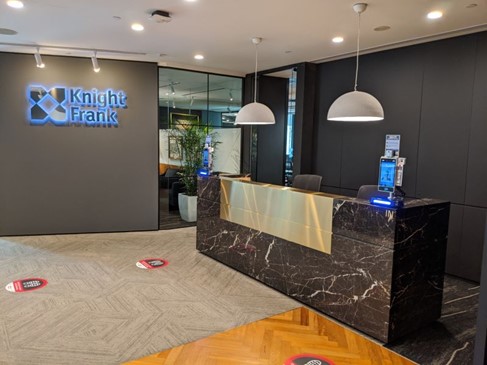What does it take to get more people back in the office in Asia-Pacific?
Landlords proactively driving transformation of the workplace through the acceleration of prop-tech.
4 minutes to read

Almost back to normal in our office, the notable difference being our temperature screening and registration scanners at reception. Photo by Calvin Yeo, Head of Corporate Real Estate, Knight Frank Singapore
Landlords obviously have a vested interest getting people back into offices and are proactively driving transformation of the workplace through the acceleration of prop-tech in buildings. CapitaLand is piloting contactless access technology and QR-activated turnstiles, while Dexus is using 3D fingerprint technology for office and car park access, as a few examples. Tokyo developers are reworking designs in upcoming office towers to make coronavirus proof-buildings with facial recognition technology, antimicrobial surfaces, and ventilation systems that will frequently recirculate air.
But is ensuring safety in the office enough to make employees want to come back? A survey by Engagerocket found that two-thirds of respondents in Singapore would prefer to work from home 50% - 75% of the time in the long run. A similar survey by UNDP in Malaysia revealed that 44% preferred working from home three or more days per week. In a Tokyo survey by Nomura Research Institute in May, 46% of respondents said they want to wish telework even after COVID-19 (down from 66% in March). But that’s not the whole picture. Knight Frank’s survey of IT workers in India found that 90% missed being in the office, while JLL’s survey across Asia-Pacific found that 66% of millennials missed the office. The common element? Both surveys revealed that people missed the social interactions and conversations that go beyond work the most. So while many employees may expect companies to offer some element of WFH as a default perk moving forward, 500 virtual calls later, we’re able to appreciate the true value of the office: the engagement that comes with collaborating face-to-face; the informal, unscheduled side conversations that make communication more efficient (and inboxes less full); and the friendly interactions you have at work that contribute positively to mental health.
Tuning into changing employee expectations
Today is an employer’s market, but once the economy recovers, the war for talent will start anew. In a pre-COVID world, the swanky office with perks like buffet lunches and sweeping city views were all part of a strategy to attract and retain the best talent. Will the office still play such an integral part in attracting talent in a post-COVID world? I think so, but not in the same way as before.
Some of the reasons why workers have embraced WFH include: increased productive hours by eliminating the office commute; the ability to spend more quality time with the family; and more flexible hours. Meanwhile, some of the challenges of WFH include working longer hours, practical aspects like distractions/space constraints/improper working environments, loneliness, as well as a difficulty in accessing tools and resources which one would normally have in the office. Not to mention the challenge of making you’re not out of sight, out of mind from upper management.
Astute employers should be paying attention to these surveys to understand how to transform the office into a valuable tool for attracting and retaining the best talent. I see the future of the office as one that is not simply offering a clean and safe environment, but one that competes with the perks and solves a lot of the problems that WFH has. It could mean companies having multiple decentralized office hubs which could reduce commute times yet offer a clear separation from home. It could mean more offices that integrate childcare facilities, replicating some of the convenience of working from home with kids but without them popping into your meetings. It could mean offering perks like employee shuttles which could ease risk of exposure to COVID-19 while on public transport. It could also mean redesigning offices to amplify the element that employees crave most: interaction and collaboration.
When employees say they want WFH to be a permanent fixture, what they’re really saying is they want the perks of WFH life, not that they never want to come back to the office.
Read my other post on the changing workplace. I have a lot more to say about the back-to-office narrative, which I feel has been told too often through a Euro-centric or America-centric lens, as well as new people dynamics that are driving tomorrow’s workplace strategy and real estate needs, and would love to hear your thoughts too.